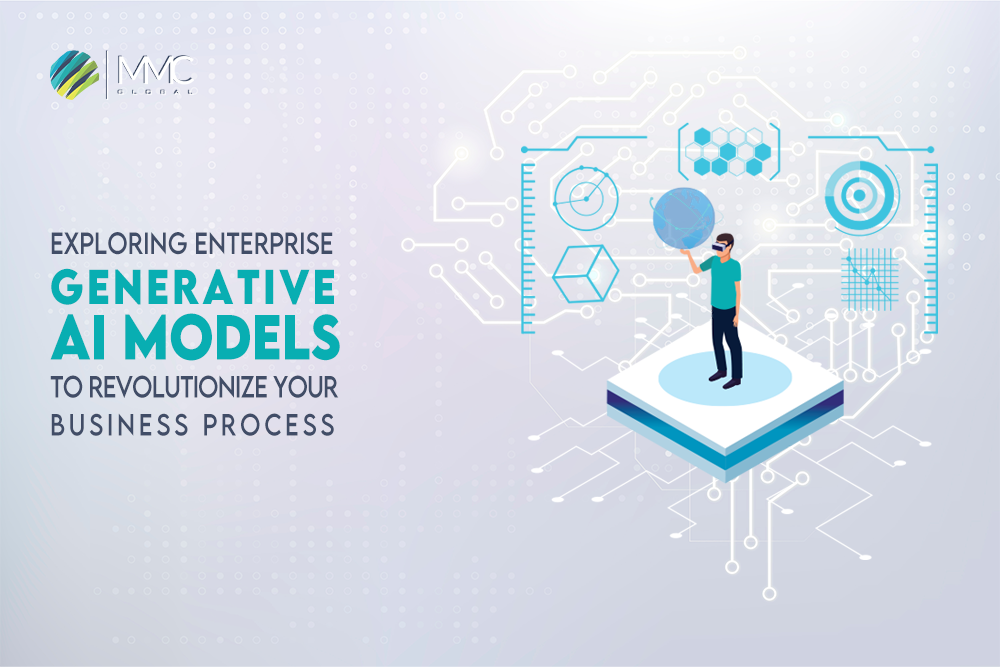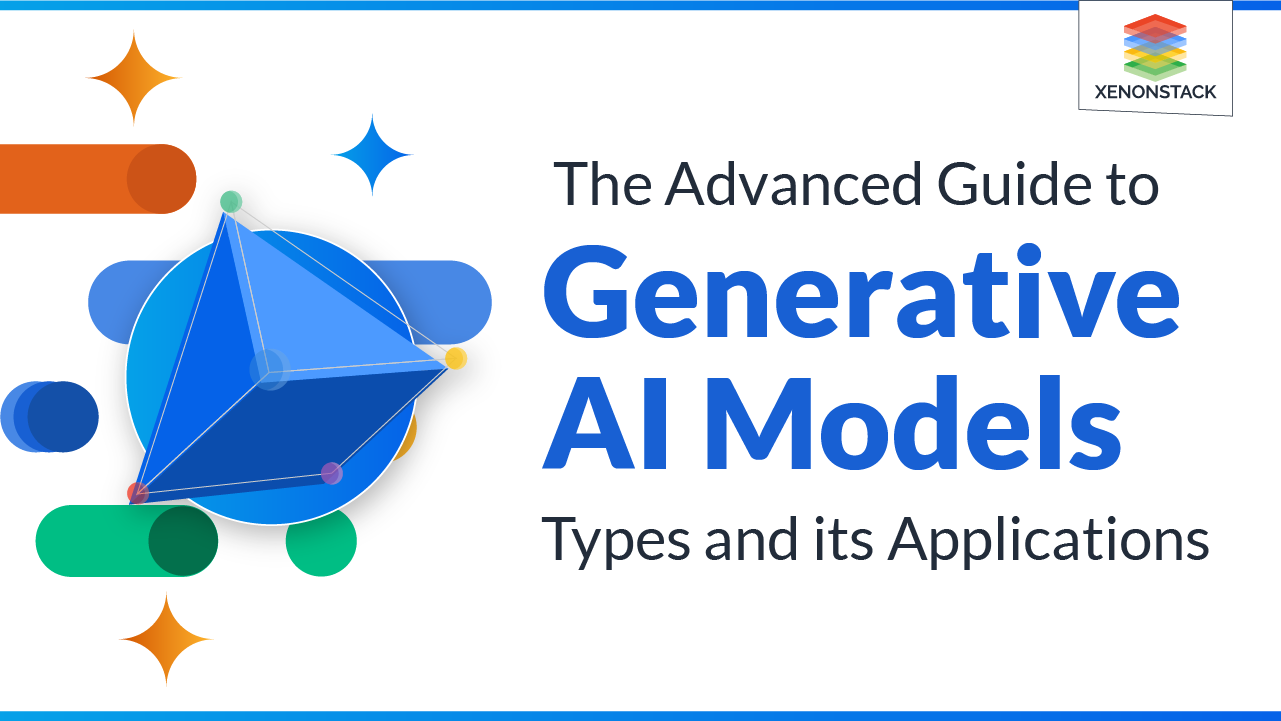Exploring Enterprise Generative AI Models: Revolutionizing Business Processes


Artificial intelligence (AI) has emerged as a metamorphic force in today’s rapidly evolving technological landscape. The aim is to reshape industries’ operations and drive innovation across the board. Generative AI Models, particularly in an enterprise context, are a notable facet of AI development making significant strides. These models, supported by advanced machine learning algorithms, have transcended their initial limitations to become essential tools for businesses.
It allows businesses to enhance their operations, create novel solutions, and gain a competitive edge. This blog post delves into the realm of Enterprise Generative AI Models, uncovering their capabilities, applications, and the latest AI workbench.
The Foundation of Generative AI Models
Generative AI Models, a subset of artificial intelligence, aim to create data similar to the input data they’ve been trained on. Unlike discriminative models, which focus on classification tasks, generative models emphasize the generation of new content. It can be images, text, music, or other forms of data.
Moreover, these models operate on the principle of learning the underlying patterns and structures of the data. Then using that knowledge to generate new instances that fit within those patterns.
The Evolution of Enterprise AI Development
Traditionally, AI development in the enterprise context revolved around predictive analytics and automation. While these applications were groundbreaking in their own right, the introduction of Generative AI Models has elevated the possibilities to unprecedented levels.
However, Enterprises now possess the capacity to harness AI for creative problem-solving, content creation, and even generating entire datasets that can be used for training other AI models.

Applications of Enterprise-Generative AI Models
Content Creation
Generative AI Models are employed to create a wide array of content, It may include realistic images and videos to written articles and music compositions.
This technology encourages creative professionals by providing them with a wellspring of inspiration, accelerating the content creation process, and expanding artistic possibilities.
Product Design and Prototyping
In industries like manufacturing and fashion, generative AI development is revolutionizing the design and prototyping stages. These models can generate numerous design variations by inputting parameters and constraints. Furthermore, it helps businesses identify optimal solutions faster and more efficiently.
Natural Language Processing (NLP) Applications
Generative AI Models are making strides in NLP applications such as content summarization, language translation, and even chatbot responses. Additionally, these models can understand context and generate human-like text, streamlining customer interactions and enhancing user experiences.
Read more: How Artificial Intelligence Technology & RPA Coexist – Explore Their Collaborative Approach
Data Augmentation
For businesses heavily reliant on data-driven processes, such as machine learning models, generative AI can synthesize new data points that augment existing datasets. This enhances model performance and generalization, particularly when dealing with limited data availability.
Anomaly Detection and Fraud Prevention
Generative models can learn the normal patterns of data and identify anomalies or outliers. In the context of enterprise security, this capability is invaluable for detecting fraud, network intrusions, or unusual activities that might otherwise go unnoticed.
Scenario Planning and Simulation
Enterprises can employ generative AI to simulate various scenarios and predict potential outcomes. It also helps in strategic planning, risk assessment, and decision-making by providing insights into the possible consequences.
The Concept of AI workbench
An AI workbench is a comprehensive platform or environment designed to facilitate and streamline various tasks and processes related to AI development, experimentation, deployment, and management.
In addition, it provides a set of tools, frameworks, libraries, and resources that enable AI practitioners and researchers to collaborate, build, test, and optimize AI models efficiently.
AI workbenches are essential components in the AI development lifecycle. They help bridge the gap between theoretical concepts as well as practical implementation.
Key Features and Components of an AI Workbench
Data Management and Preparation
AI workbenches often include tools for data preprocessing, transformation, and augmentation. They enable users to clean, format, and organize data for training and testing AI models.
Model Development and Experimentation
These platforms provide a range of machine learning and deep learning frameworks and libraries. It allows users to build, train, and experiment with different AI models. In fact, users can tweak model architectures, hyperparameters, and algorithms to find the best-performing solutions.
Visualization and Interpretability
AI workbenches offer visualization tools to help users understand and interpret their model’s performance. It makes analyzing metrics, visualizing data distributions, and identifying patterns or anomalies easier.
Collaboration and Version Control
Collaboration features within AI workbenches allow multiple team members to work on the same projects simultaneously. Version control mechanisms help manage changes, track progress, and maintain consistency across different iterations of the AI models.
Model Deployment and Monitoring
Once an AI model is trained and optimized, workbenches often provide tools for deploying models into production environments. These tools manage the deployment pipeline, scale, and monitor the deployed models’ performance.
AutoML and Hyperparameter Tuning
Some AI workbenches offer automated machine learning (AutoML) capabilities, which automate tasks like model selection, hyperparameter tuning, as well as feature engineering to simplify the model development process.
Cloud Integration
Many AI workbenches integrate with cloud platforms, allowing users to leverage cloud computing resources for training and deploying AI models. Consequently, it enables cost-efficient scalability and access to powerful hardware.
Documentation and Experiment Tracking
To maintain a clear record of experiments, AI workbenches often include features for documenting experimental setups, results, and insights. Moreover, it helps in reproducibility and knowledge sharing.
Security and Compliance
Enterprise-grade AI workbenches prioritize security and compliance by offering authentication, authorization, and data protection features to safeguard sensitive information.
Education and Learning Resources
Some AI workbenches provide educational resources such as tutorials, sample projects, and documentation to help users learn about AI concepts and tools.
Workflow Automation
Workflow automation features help streamline repetitive tasks. It enables users to create pipelines that automate data processing, model training, and deployment processes.
Read more: 5 SharePoint Workflows That Automate Your Business Operation Process
What is the AI workbench for Enterprise Generative AI Models?
An AI workbench for Enterprise Generative AI Models is a specialized platform or environment tailored to support generative AI models’ development, deployment, and management within an enterprise context.
In fact, this workbench type harnesses generative AI models’ capabilities to solve complex business challenges, drive transformation, and optimize various processes. It provides tools, resources, and features that cater to the unique requirements and demands of creating generative AI development solutions in enterprise settings.
Key Features and Components of an AI Workbench for Enterprise Generative AI Models
Generative Model Libraries
The workbench includes libraries and frameworks specifically designed for generative AI. It offers pre-built architectures and algorithms that enable users to create a broad spectrum of productive content.
Customization Tools
Enterprises often require tailored solutions. In fact, the workbench provides customization capabilities to fine-tune generative models according to the specific needs and goals of the business.
Data Integration and Management
These workbenches facilitate the integration and preprocessing of enterprise data, ensuring that the generative models can access relevant and high-quality data for training.
Collaborative Environment
Since generative AI projects often involve cross-functional teams, the workbench provides collaboration features to allow data scientists, designers, developers, and domain experts to work together seamlessly.
Security and Compliance
Given the sensitivity of enterprise data, the workbench prioritizes security mechanisms and compliance protocols to protect data privacy and intellectual property.
Workflow Automation
These platforms offer automation tools to streamline the end-to-end process of generative model development, from data preparation and model training to deployment and monitoring.
Version Control and Experiment Tracking
To ensure transparency and reproducibility, the workbench includes features for version control, experiment tracking, and documentation of generative model development iterations.
Model Deployment and Monitoring
An essential aspect of enterprise AI solutions, the workbench facilitates the deployment of generative models into production environments and provides monitoring tools to track model performance over time.
Scenario Simulation
Enterprises often use generative models for scenario planning and simulation. The workbench supports creating and testing multiple scenarios to aid strategic decision-making.
Model Interpretability
Understanding how generative models make decisions is crucial for enterprise applications. The workbench also provides tools to interpret model outputs and provide insights into the generated content.
AutoML for Generative AI
Some workbenches offer automated model architecture and hyperparameter search tailored to generative AI, simplifying the model selection and tuning process.
Domain-Specific Features
Depending on the industry and use cases, the workbench might include domain-specific tools and resources that cater to the unique needs of sectors such as healthcare, finance, manufacturing, and more.
Education and Training Resources
To help users gain a better understanding of generative AI concepts and techniques, the workbench might offer tutorials, documentation, and educational materials.
Cloud Integration
Enterprises can leverage cloud resources for scalable computing power. The workbench might integrate with cloud platforms for efficient model training and deployment.
Popular AI Workbenches for Enterprise Generative AI Models:
NVIDIA Clara: Designed for healthcare applications, this platform provides tools for developing AI models, including generative models, to support medical image analysis and other healthcare-related tasks.
OpenAI Platform: OpenAI’s GPT models are widely used for various generative AI applications, and the platform provides resources and guidelines for deploying and using these models in enterprise contexts.
Amazon SageMaker: Amazon’s platform offers tools for building, training, and deploying generative AI models using cloud resources.
Google AI Platform: Google’s platform provides resources for creating and deploying AI models, including generative models, leveraging Google Cloud services.
Hugging Face: Hugging Face’s Transformers library offers pre-trained models for various NLP tasks, including text generation, and can be integrated into an enterprise AI pipeline.
The Road Ahead
Enterprise Generative AI Models are on an exponential trajectory, with advancements occurring astonishingly. Businesses must stay updated on the latest developments and consider how these models can be integrated into their operations. As these models become more accessible and user-friendly, enterprises of all sizes can tap into their potential for innovation and optimization. However, a cautious and ethical approach is imperative to harness the benefits without compromising integrity and responsibility.
Read more: 3 Ways Companies Can Start Implementing AI
In conclusion, Enterprise Generative AI Models are reshaping the business landscape by unlocking new avenues of creativity, problem-solving, and efficiency. Businesses must embrace these technological advancements mindfully, ensuring they are leveraged for positive transformation while upholding ethical standards and data privacy. The era of Enterprise Generative AI Models is here, and it’s up to businesses to seize the opportunities they bring.
As we move forward, an AI workbench for Enterprise Generative AI Models is a pivotal tool for organizations looking to leverage generative AI’s creative and problem-solving capabilities for their business needs. By providing a comprehensive environment that addresses the unique challenges of generative AI within enterprise contexts, these workbenches enable businesses to innovate, optimize processes, and gain a competitive edge in their respective industries.



